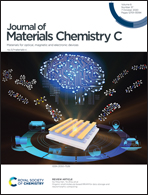Exploiting two-dimensional hybrid perovskites incorporating secondary amines for high-performance array photodetection†
Abstract
Two-dimensional (2D) multilayered hybrid perovskites have emerged as a promising class of candidates for photovoltaic and photoelectric applications. Currently, most of the 2D multilayered motifs consist of primary amines, while the candidates that accommodate large-size organic cations inside the perovskite cavity as the “perovskiter” component are still scarce. Herein, we exploit a new 2D Ruddlesden–Popper hybrid perovskite, (C5H11NH3)2(CH3NH2CH3)Pb2I7 (1), in which the secondary dimethylammonium cation (i.e., CH3NH2CH3+) acts as the “perovskiter” inside the inorganic {Pb2I7}n perovskite framework. Its quantum-well like structure, formed by alternating the organic spacer (C5H11NH3+) and inorganic sheets, would facilitate the dissociation of photoexcited electron–hole pairs and improve the performance of the optoelectronic device. Consequently, the planar array detector based on high-quality crystals of 1 exhibits fascinating photoresponses, including high responsivity (∼0.67 A W−1), notable detectivity (∼1.65 × 1012 Jones), large photocurrent ratio (∼1.1 × 104) and fast responding rate (∼270 μs). These behaviors are closely associated with its strong in-plane photoactivities related to the perovskite sheets, and extremely low dark current (∼10−11 A) inhibited by the hopping barriers of organic spacer cations. This study paves the potential way to build high-performance optoelectronic devices based on the emerging 2D single-crystal hybrid perovskite materials.

- This article is part of the themed collection: Journal of Materials Chemistry C HOT Papers


 Please wait while we load your content...
Please wait while we load your content...